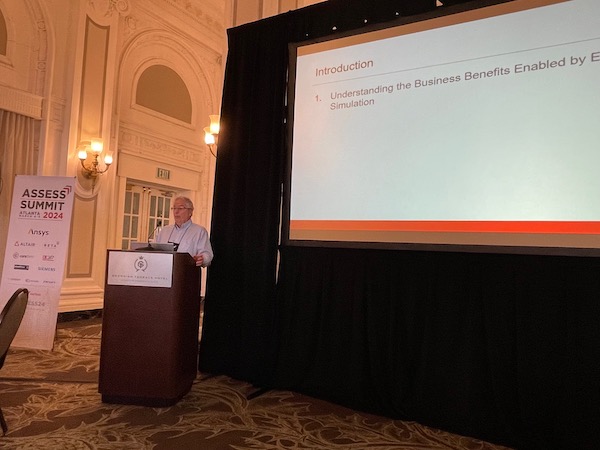
ASSESS Initiative director Joe Walsh at the ASSESS Summit in Georgia.
March 22, 2024
For simulation evangelists, efforts to expand the use of the technology across the design cycle are finally paying off – is the industry ready?
That was an overarching theme at the recent ASSESS Summit. Held in Atlanta March 4-6, the ASSESS Summit 2024 drew a small group of leading simulation software providers, users, academics, and researchers together for three days of presentations and roundtable discussions about innovative users of simulation and the opportunities and challenges facing the market.
NAFEMS CEO Tim Morris and ASSESS Initiative director Joe Walsh kicked off day one with an overview of the expanding role of simulation in engineering, and an update on ASSESS activities. In 2023, the group completed work on a new strategic insight paper (Understanding the Path to Realizable Business Benefits through Engineering Simulation) and released the ASSESS Engineering Simulation Metadata Specification (ESMS) metadata specification, formerly the Unified Model Characteristics for Engineering Simulation (UMC4ES).
Increasing use of simulation tools also indicates that the original mission of ASSESS – to expand and democratize the use of simulation – is coming to pass.
Demand for simulation is still growing, and the simulation revolution is occurring, Walsh said. The inflection point is coming. We can feel it.
The industry, Walsh said, is finding a balance to allow for appropriate use of simulation among different types of stakeholders, without degrading simulation results.
The event featured two keynotes. On March 5, the event opened with a keynote session titled Reduced-Order Models as Enablers for Design, Control and Predictive Digital Twins, presented by Karen E. Wilcox, director of the Oden Institute for Computational Engineering and Sciences at the University of Texas at Austin. The March 6 keynote was titled Modeling: Mastery, Marketing & Making Decisions, led by Alison Main, Research and Development Senior Director for Corporate Functions R&D at Procter & Gamble.
Wilcox shared the results of digital twin research conducted by the National Academies. Main described how P&G leverages simulation for a wide variety of activities, from chemistry and product design, to packaging and even consumer behavior modeling.
Other presentations included an overview of corrosion simulation from Corrdesa; an overview of bioinspired generative design from the University of Belfast; a look at verification, validation and uncertainty quantification from Rolls Royce; and a presentation on scaling metadata extraction with large language models from the Aerospace Systems Design Laboratory.
McKinsey & Co. shared initial results from a study (conducted in collaboration with NAFEMS) on the business impact of engineering simulation in the automotive industry that showed simulation maturity can result in a 20% to 30% time to market improvement and up to a 30% product performance improvement, depending on the application.
The research found that the application with the highest level of simulation maturity in automotive was in design of body structures. The study also examined some of the emerging uses of artificial intelligence and machine learning (ML) in these applications.
Petra Gartzen, a consultant at market research firm Cambashi, provided an update on simulation market trends. She noted that the move to the cloud, the use of virtual resources, and the acceleration from prototyping to virtual testing were accelerating the adoption of simulation. Global instability and ongoing wars are fueling a resurgent demand for simulation in the aerospace market, which has returned to its prepandemic growth rate of 15% in terms of demand for manufacturing software.
The automotive market has recovered with a 15% growth rate that has since dropped to 10%, and is expected to settle down to 5% after pent-up demand is met.
CAE is the fastest growing industry segment with a CAGR of 9.5% over the past 17 years, and has been growing faster than CAD and PLM since 2010. CAE software revenue is expected to double over the next seven years.
Now that simulation use is growing, attendees and presenters discussed the importance of making the business case for simulation to executive leadership, and the importance of consistency, quality, and (eventually) interoperability of data and solutions. Presenters emphasized that simulation is merely a means to an end – a way for engineers and companies to make better decisions.
To learn more about the ASSESS Summit 2024, visit the website or browse the resources and presentations here.
More ASSESS Initiative Coverage
Subscribe to our FREE magazine, FREE email newsletters or both!
About the Author
Brian Albright is the editorial director of Digital Engineering. Contact him at de-editors@digitaleng.news.
Follow DE





